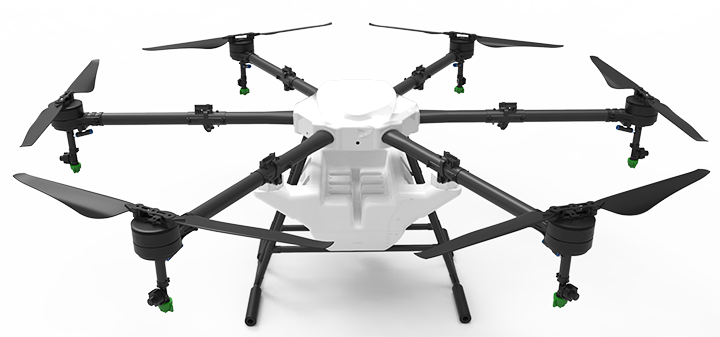
For two straight growing seasons, crop fields in a portion of Ukraine have benefited from unmanned aircraft vehicles used to spray bio-pesticide and liquid fertilizer. Although large-scale unmanned aircraft systems designed for precision agriculture surveying, data collection or liquids application have long caught the eye of investors, crop experts and UAS operators, the viable economic and logistical connection between UAVs and the ag field has yet to be made in a significant, repeatable and scalable way. Yuriy Pederii, a flight simulation design expert with 10 years of work at Microsoft, hopes his two years spent flying back and forth above thousands of acres of grain fields could change the reality for drones and their place in the crop spraying industry.
Pederii has created a drone-based aerial liquids application company called AeroDrone. The German-based firm flew its fixed-wing autonomous UAV fleet from 2014 and 2016, testing and redesigning the flight software and autonomous flight capabilities along with the entire infrastructure linked to storing and applying micro droplets of biocide or liquid fertilizer.
Pederii has a simple view on the need for his services on a global scale, but a detailed perspective on how drones—particularly a fleet of them potentially flying at night—can fit into the world’s needs. The key purpose of his work, he said, is defined by the demand for food. “The area of arable, tillable land per captia will only decrease over time,” he said. To meet that need, Pederii has become a flight software designer well- versed in the intricacies of aerial application, a feat his business partner and lead investor Mark Erjavec believes will pay off soon.
The UAV At Work
The fixed-wing, gas powered system is designed to fly at roughly 22 feet above the field. In one day, a drone can cover 1,000 acres at 50 acres per flight. No specific runway type is needed, only a space with dimensions of 50 feet wide by 390 feet long. From start to finish, the unit flies autonomously, although an operator pilot can take control of the unit to manage obstacles such as powerlines, other crop dusters or trees.
In a typical scenario, a user would arrive at a field location, attach the wings, upload a flight plan to a tablet, fill the chemical storage containers in be in air 20 minutes after arrival. Once in flight, the software is designed to continually calculate wind speeds, fluid levels—both fuel and chemicals to be sprayed—and the angle or degree of climb needed to make turns. The calculations are then fed into an intricate algorithm that maintains the desired spray ratio of fluid over the field. Before the flight or during, the system can also adjust the angle of spray or the distance between each line, or pass, of spraying the UAV makes. Sensors in the fuel tank are working throughout the flight and when fuel levels are low, the system automatically returns to its starting point for refueling.
According to Pederii, the challenge in the beginning was to make the autopilot perform as well and accurate at the beginning of each flight as it did at the end of each flight. The UAV starts its flight with a full tank of chemical and fuel, but flies with up to 30 percent less weight by the end of each in-air period. Pederii had to integrate sensors into the flight software that would take into account the constantly changing weight profile of the operation. Essentially, he said, the system works based on the weight of chemical left in the tanks situated on each wing.
To accurately apply liquids, the team utilizes a micro droplet approach to spraying. Instead of big droplet spraying that typically requires a water-based mixture, the system is based on spraying pure chemical liquids roughly 100 microns in size. The droplets are small enough to avoid chemical burnout on the weed or crop below, Pederii said.
The flight characteristics are used to stream the chemicals from the tanks to the ground. Through a small tube, the chemicals are pushed to the vortex of the wing tips. Spray—through the inductive energy of the wind on the wing tips—is able to reach out up to approximately 60 feet out from the UAV.
Post flight, the autonomous system is able to record its flight path so that after one flight, a pilot should not be needed to interject during a flight. The chemical spray data is also saved, and in some cases, can be used as evidence by farmers questioned about the drift of chemicals above their fields.
The System In America
Due to a less-stringent regulatory environment in Ukraine, Pederii and Erjavec were able to test and perfect the system for two years in various weather scenarios. Now, the team is manufacturing a fleet of 50 larger units capable of flying longer with larger chemical storage loads. In two years, the team hopes to have concluded the regulatory certification and testing work required by the U.S. to fly the systems, Erjavec said.
The new systems will be equipped with parachutes. Night spraying is also a major focus of the team as it looks to continue proving out the value proposition for the units. The current systems cost roughly $75,000 which includes all flight software and parts. Fuel burn is 70 percent less on the UAVs versus conventional ground-based systems. The company is currently flying commercially for clients in less restricted airspace in areas of Ukraine and is in discussions with customers in Australia and Indonesia. The cost per acre to use the units ranges from $1.75 to $2.00. Patents have been secured for the method of spraying using drone technology and for the drone airframe.
Contact: Fly Dragon Drone Tech.
Email: frank at dronefromchina.com
Add: NO. 9 Dayu Road PiDu distric, ChengDu 611730, China